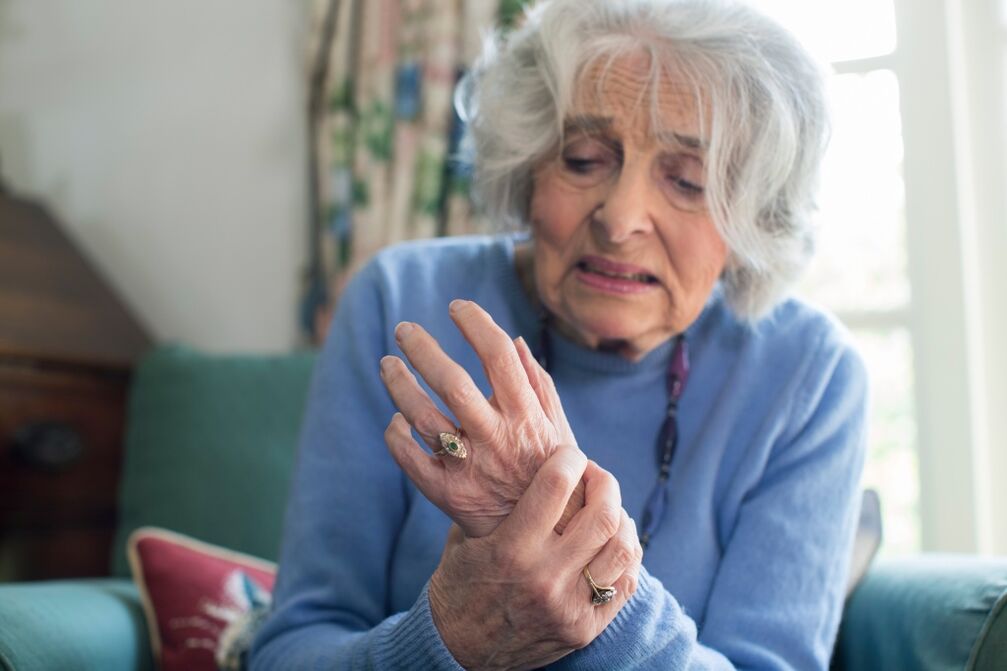
Arthrosis of the joints (the terms "deforming arthrosis", "arthrosis" or "arthrosis" are also found in the literature) is a chronically degenerative process of the joint tissue in which, due to dystrophic processes, the cartilage covering the joint surfaces is destroyed over time, In addition, degenerative processes can cover the joint capsule and the actual bone tissue, causing bone deformation.
Types of osteoarthritis of the joints
In general, the term "osteoarthritis" is used to refer to a fairly large group of diseases affecting various joints. The mechanism of development of such pathologies can differ to some extent. Most often, osteoarthritis of large joints can occur. This group of diseases includes:
- Gonarthrosis - a deforming lesion of the knee joint;
- Coxarthrosis - a pathology of the hip joint;
- Osteoarthritis of the shoulder joint;
- Osteoarthritis of the elbow joint, etc.
Osteoarthritis of small joints develops less often: hands (more often interphalangeal and metacarpophalangeal) and feet. In addition, a distinction is made between spondyloarthrosis - a dystrophic lesion of the intervertebral joints, which, despite the similar development mechanism as in other types of osteoarthritis, is called diseases of the spine. In the event that the pathology has spread to several joints, we can talk about generalized osteoarthritis or - polyarthrosis.
In medicine, it is customary to distinguish two main types of osteoarthritis of the joints, depending on the mechanism of its development. Primary osteoarthritis (also called idiopathic) is a pathology that develops mainly in the tissues of the joint, outside of deviations in the systemic work of the body. Primary osteoarthritis is characterized by an increase in degenerative processes in cartilage tissue with a simultaneous violation of its restoration.
Secondary osteoarthritis is the result of injury to the joint due to trauma (traumatic osteoarthritis). In addition, certain pathological processes in the body, especially disorders of mineral metabolism and others, can lead to the development of secondary osteoarthritis.
Traumatic osteoarthritis is usually diagnosed at a young age. In the elderly, in some cases, it is not possible to distinguish between primary and secondary joint damage - so many pathological processes in the body are closely related.

Why does osteoarthritis develop?
Despite the fact that there is still no consensus on the exact cause of the development of osteoarthritis, scientists are aware of the factors that contribute to pathological changes in the tissues of the joint. The main reason for the development of idiopathic osteoarthritis of the joints is a large number of factors of a hereditary and genetic nature. This group includes, first of all, innate features of the composition of the joint tissues, which contribute to more intense than normal destruction of cartilage and its too slow recovery. In addition, hereditary factors can include a wide variety of congenital defects and deformities of the osteoarticular system (dysplasia of the joints, their excessive mobility, deformities of the spine, feet, hands, etc. ), due to which excessive or non-physiological stress on certain joints. Why can the articular surfaces develop incorrectly, deform, and the cartilage covering them collapse
The following reasons can lead to the development of secondary osteoarthritis of the joints:
- Mechanical damage to the joints is the result of certain mechanical influences that lead to a violation of the anatomical integrity of the structures that make up the joint. The group of mechanical injuries includes injuries, surgery, excessive physical activity, and sports;
- Joint diseases - especially inflammatory diseases;
- Metabolic disorders that lead to changes in the composition of the cartilage that covers the articular surfaces, making it more vulnerable, breaking down faster, and recovering more slowly;
- some diseases of the endocrine glands, which can also lead to metabolic disorders;
- a number of autoimmune diseases in which the cells of the immune system attack the body's own tissues, in this case the tissues of the joints, resulting in destruction;
- Vascular pathologies, the consequence of which is insufficient blood supply to tissues and the development of dystrophic processes in them.
How does osteoarthritis of the joints develop?
It is believed that the first destructive process in the joint in osteoarthritis of the joints is the defeat of the cartilage. It begins with a violation of microcirculation in the capillaries of the periosteum, which are located under the cartilage that covers the articular surface of the bone. Normally, nutrients in cartilage come from both the synovial fluid and the adjacent bone tissue. If the blood circulation in the vessels of the periosteum is disturbed, then the nutrition of the cartilage is disturbed. Gradually, the cartilage tissue loses its natural elasticity, becomes thinner, its surface becomes uneven, microcracks and tubercles can appear on it and interfere with the sliding of the articular surfaces relative to each other. The composition of the synovial fluid inevitably changes.
When moving in the joint, pain, crunching, and clicks begin to interfere. Over time, the pathology progresses, the range of motion in the joint decreases, the joint space becomes narrower, the cartilage on the protruding parts of the articular surfaces can thin until it disappears completely, and osteophytes form on the edges of the articular surfaces.
The mechanism described is particularly characteristic of senile osteoarthritis, which gradually develops over time. The mechanism of development of other forms of osteoarthritis - for example, post-traumatic, post-operative, post-infectious, associated with metabolic disorders - can be slightly different, but in general, changes in the joint with such pathologies are identical to senile osteoarthritis.
The degree of osteoarthritis and its manifestations
The specific manifestations of the pathological process and their severity largely depend on how intense the destructive process is in the joint and how much tissue is involved in it. However, at each stage there are two main clinical symptoms that are characteristic of osteoarthritis. First of all, it's joint pain. In addition, the decrease in joint mobility is worrying.
In our country, it is customary to distinguish the degree of osteoarthritis according to the clinical and radiological classification adopted in 1961.
Osteoarthritis of the joints 1 degree- the initial stage of the development of the pathological process.The main symptom is stiff joint movements in the morning after rest. As soon as the patient starts moving, the stiffness disappears. In the joints, mobility can be impaired to a certain extent; minor pain can interfere with the first movements after resting. Cracks are often found in the joints. However, there is no pronounced pain after normal movements, pain can only appear with a significantly excessive load on the joint, and after resting it will go away on its own.
The X-ray examination of the affected joint does not show any pronounced changes in the anatomical structures. In some cases, there may be a slight narrowing of the joint space or the presence of individual small bone growths along the edges of the joint surface.
Due to the lack of obvious pain and movement disorders in the joint, patients rarely seek medical help at this stage of disease development.
2 degrees of osteoarthritis - the progression of the disease.It manifests itself in severe, acute pain and a distinct crunch that clicks into the joint when you move. The range of motion in the joint is significantly limited, which is why, if it is a question of the defeat of a large joint, the development of functional shortening of the limb is possible. The pain is annoying in the morning, immediately after waking up, as in the first stage of osteoarthritis, but in contrast, it is more intense, longer, and often it gradually turns into daytime pain. The latter occur during the day when the amortization capacity of the cartilage gradually decreases due to mechanical work in the joint. At this stage, there is significant destruction of the joint and deformation of the bones that make it up. The meteosensitivity of the joint can be disruptive: the appearance or significant increase in pain with changes in the joint, which is associated with a decrease in the compensatory properties of the joint tissue and its ability to regulate intra-articular pressure with atmospheric fluctuations pressure.
X-ray examination shows a significant narrowing of the joint space, a significant number of bone growth. Bone tissue in the pericartilaginous zone is sclerosed due to pronounced dystrophic processes, in which cystic cavities can form.
At this stage of the disease, the patient's ability to work decreases, since due to severe pain during the movements of the affected joint or its contracture, he cannot do any work at all.
The arthrosis of the joints of the 3rd degree corresponds to the advanced stage of the pathological process.The pain is constantly disturbing - both during movement and in a state of complete rest, which is associated with a number of factors: inflammation of the joint tissues, deformation of the articular surfaces, muscle spasms around it. The range of motion is severely restricted, in some cases they are usually not possible. Movement in the affected joint is accompanied by a loud crunch that is audible not only to the patient but also to those around him. The joint is significantly deformed at this stage, fluid accumulates in the joint capsule due to the intense inflammatory process. A severe meteosensitivity arises: Pain intensification through weather changes. The muscles in the area of large joints are spasmodic, due to lack of mobility, their atrophy can develop. With 3rd degree osteoarthritis of the knee joints, a curvature of the legs can be noted - varus (in the form of the letter "O") or valgus (in the form of the letter "X").
X-rays show an almost complete absence of the joint space, the joint surfaces are significantly deformed, and large bone growths are located on their edges. Intra-articular structures (menisci, ligaments) are destroyed, bone tissue is sclerosed. The tissues around the joint are calcified, joint mice can appear in the joint cavity - fragments of bone tissue.
With osteoarthritis of the joints of the third degree, there is a persistent decrease in the patient's ability to work, his disability.
4 degrees of osteoarthritis - the stage of complete destruction of the affected joint.Its "blockage" develops - the impossibility of even the slightest movement due to severe pain. Pain cannot even be relieved by strong non-narcotic analgesics, it is not relieved by physical therapy procedures. With the defeat of the knee joints, the patient loses the ability to move independently. Severe inflammation in the tissues of the joint can cause the joint to fuse (ankylosis) or the formation of false joints (neoarthrosis).
The X-ray shows the strongest sclerosis of the bones forming the joint, their fusion, a large number of osteophytes and intense calcification of the joint tissue.
How is osteoarthritis treated?
The scope of therapeutic measures for the treatment of osteoarthritis of the joints depends on the stage of the disease and the prevalence of the pathological process. There is a simple pattern: the earlier treatment for osteoarthritis is started, the more effective it is. Therefore, it is very important to consult a doctor in a timely manner, at the first signs of discomfort in the joint area, at the slightest morning stiffness or the appearance of a crunch during movements. At the initial stage of the pathological process, it is effective to take vitamin-mineral complexes and chondroprotectors - drugs that improve the metabolism in cartilage tissue and its structure. For example, a drug whose active ingredient is crystalline glucosamine sulfate - a natural component of healthy cartilage. It stimulates the production of proteoglycans and at the same time inhibits the processes of destruction of cartilage tissue.

A good addition to the listed measures for the treatment of osteoarthritis are physiotherapy exercises, physiotherapy techniques. It is important to have a good diet with an adequate amount of proteins and fats in the diet. Timely therapeutic and prophylactic measures make it possible not only to get rid of pain and discomfort, but also to prevent the progression of the disease, the transition of pathology to more severe stages.
Second and severe degree osteoarthritis cannot be completely cured. At these stages, treatment for osteoarthritis is reduced to eliminating or reducing pain, as well as suppressing inflammation in the tissues of the joint. For pain relief, nonsteroidal anti-inflammatory drugs and non-narcotic analgesics in the form of local agents (ointments, gels with anesthetic and anti-inflammatory effects), as well as systemic drugs are used. The relief of the diseased joint plays an important role, as a result of which mechanical damage to the joint surfaces can be reduced.
After the acute pain is eliminated, an important task is to normalize the metabolic processes in the cartilage tissue and to slow down the destructive processes in the cartilage tissue. It is also recommended to take chondroprotective drugs. Medicines that stimulate tissue microcirculation have also proven their worth. In the remission stage of osteoarthritis (without severe pain), physical therapy exercises and physical therapy are useful, which will reduce the likelihood of further exacerbation and reduce the need for analgesics and NSAIDs.
The list of physiotherapeutic measures to treat osteoarthritis of the joints includes electrophoresis, ultrasound exposure, radiation, and magnetic therapy. The main requirement for the effectiveness of such measures is to conduct physiotherapeutic treatment of osteoarthritis only during the period outside of the exacerbation of the disease, otherwise there is a high probability of activating the inflammatory process and exacerbating pain.
How to treat osteoarthritis in the fourth stage of the diseaseThe joint tissue is practically destroyed at this stage, the only effective solution is a surgical procedure, during which the damaged joint is replaced with a special endoprosthesis. Such an operation cannot always completely restore the range of motion of the joint. However, after the recovery period is completed, the patient can return to active life, work and get rid of pain.
Osteoarthritis, the symptoms and treatment of which are described in this article, is a serious pathology that can cause disability and significantly affect the quality of life. Timely start of treatment can significantly slow the progression of the disease, avoid the development of serious complications, and maintain the patient's activity and ability to work.




















